Cervis SRF309 Radio Module, DSSS, 10mW, 900MHz User Manual
Cervis Inc. Radio Module, DSSS, 10mW, 900MHz Users Manual
Cervis >
Users Manual
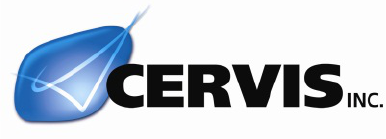
2014 Cervis, Inc.
SRF309 User Manual
18 August 2014
U081.0.9 User Manual for SRF309
™
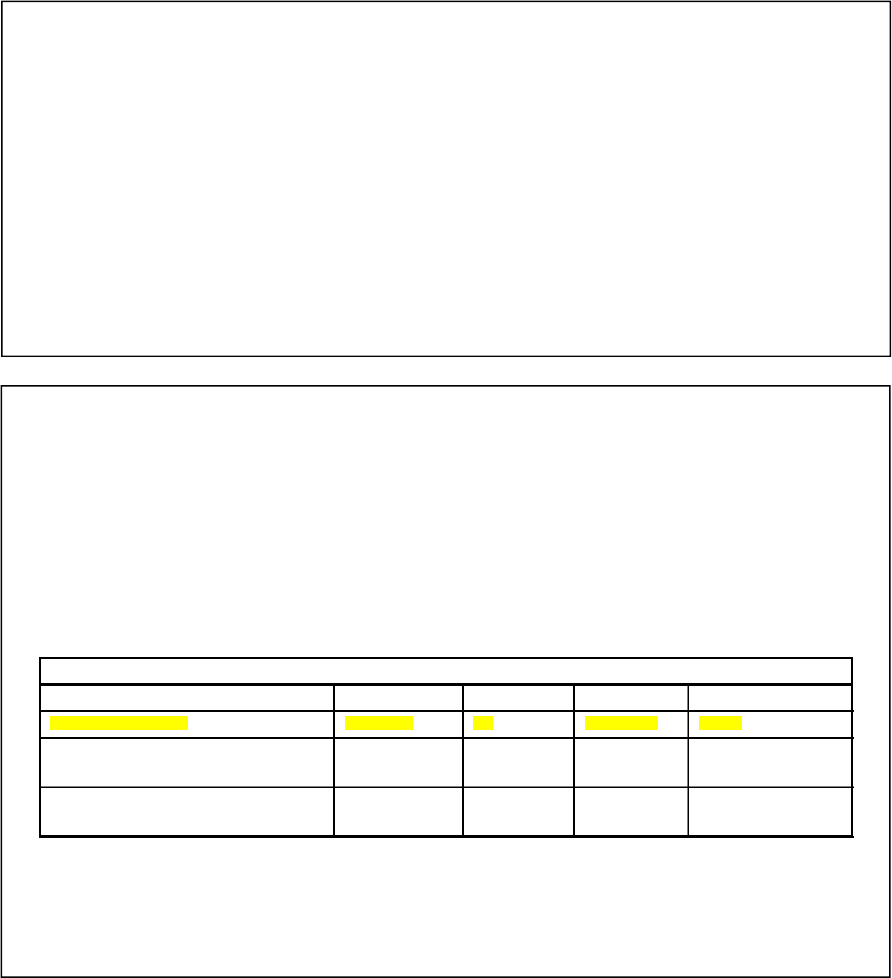
Module SRF309
This document is the property of Cervis, Inc. and cannot be copied, modified, e-mailed, or reproduced
without the express prior written consent of Cervis, Inc.
Cervis, Inc. reserves the right to change this manual or edit, delete, or modify any information without prior
notification.
Industry Canada Statements
RSS-GEN 7.1.2 – Transmitter Antenna / Antenne de L'émetteur
Under Industry Canada regulations, this radio transmitter may only operate using an antenna of a type and maximum (or lesser) gain approved for the transmitter
by Industry Canada. To reduce potential radio interference to other users, the antenna type and its gain should be so chosen that the equivalent isotropically
radiated power (e.i.r.p.) is not more than that necessary for successful communication.
Conformément à la réglementation d'Industrie Canada, le présent émetteur radio peut fonctionner avec une antenne d'un type et d'un gain maximal (ou inférieur)
approuvé pour l'émetteur par Industrie Canada. Dans le but de réduire les risques de brouillage radioélectrique à l'intention des autres utilisateurs, il faut choisir le
type d'antenne et son gain de sorte que la puissance isotrope rayonnée équivalente (p.i.r.e.) ne dépasse pas l'intensité nécessaire à l'établissement d'une
communication satisfaisante.
This radio transmitter 7955A-SRF309 has been approved by Industry Canada to operate with the antenna types listed below with the maximum permissible gain
and required antenna impedance for each antenna type indicated. Antenna types not included in this list, having a gain greater than the maximum gain indicated
for that type, are strictly prohibited for use with this device.
Le présent émetteur radio 7955A-SRF309 a été approuvé par Industrie Canada pour fonctionner avec les types d'antenne énumérés ci-dessous et ayant un gain
admissible maximal et l'impédance requise pour chaque type d'antenne. Les types d'antenne non inclus dans cette liste, ou dont le gain est supérieur au gain
maximal indiqué, sont strictement interdits pour l'exploitation de l'émetteur.
Approved Antenna List / Liste Antenne Approuvé
Manufacturer Part Number Stock Number Gain Impedance
Antenna-Factor/Linx Tech ANT-916-SP 353 +1.49dBipeak 50 Ohm
Nearson
Or Equivalent
S467TR-915S
Or Equivalent
BB3-06 +2dBipeak 50 Ohm
Superpass
Or Equivalent
SPDAC80
Or equivalent
BB3-08 +9dBipeak 50 Ohm
RSS-GEN 7.1.3 – Notice / Délai
This device complies with Industry Canada licence-exempt RSS standard(s). Operation is subject to the following two conditions: (1) this device may not cause
interference, and (2) this device must accept any interference, including interference that may cause undesired operation of the device.
Le présent appareil est conforme aux CNR d'Industrie Canada applicables aux appareils radio exempts de licence. L'exploitation est autorisée aux deux
conditions suivantes : (1) l'appareil ne doit pas produire de brouillage, et (2) l'utilisateur de l'appareil doit accepter tout brouillage radioélectrique subi, même si le
brouillage est susceptible d'en compromettre le fonctionnement.
FCC Statements
15.19 – Two Part Warning
This device complies with Part 15 of the FCC rules. Operation is subject to the following two conditions:
(1) This device may not cause harmful interference and
(2) This device must accept any interference received, including interference that may cause undesired operation.
15.21 – Unauthorized Modification
NOTICE: The manufacturer is not responsible for any unauthorized modifications to this equipment made by the user. Such modifications could void the user’s
authority to operate the equipment.
15.27 – Special Accessories
This device is supplied with special accessories that include an RF adapter cable and antenna. These special accessories must be used with the device. It is the
responsibility of the user to use the needed special accessories supplied with the equipment.
15.105(b) – Note:
This equipment has been tested and found to comply with the limits for a Class A digital device, pursuant to part 15 of the FCC Rules. These limits are designed
to provide reasonable protection against harmful interference when the equipment is operated in a commercial environment. This equipment generates, uses,
and can radiate radio frequency energy and, if not installed and used in accordance with the instruction manual, may cause harmful interference to radio
communications. Operation of this equipment in a residential area is likely to cause harmful interference in which case the user will be required to correct the
interference at his own expense.

User Manual
2014Cervis, Inc. i
Table of Contents
Table of Contents .......................................................................................................................... i
List of Figures ............................................................................................................................... i
List of Tables ................................................................................................................................. i
Cervis Inc. Safety Precautions ................................................................................................... 1
1.0SRF309 Introduction ............................................................................................................ 2
1.1SRF309 Features ............................................................................................................... 2
1.2SRF309 Pinouts ................................................................................................................ 3
2.0SRF309 Installation .............................................................................................................. 9
3.0SRF309 Tune-up Procedure ................................................................................................ 9
4.0SRF309 Electrical Characteristics ...................................................................................... 9
4.1Supply Voltage and Current ............................................................................................ 9
4.2Operating Current ........................................................................................................... 10
4.3SPI Interface .................................................................................................................... 10
5.0SRF309 RF Characteristics ............................................................................................... 10
List of Figures
Figure 1. SRF309 RF section Front .............................................................................................. 3
Figure 2. SRF309 RF section Back ............................................................................................... 3
Figure 3. 07440305-9H-12R, component side, shield removed ................................................. 5
Figure 4. 07420305-9H-12R, component side .............................................................................. 7
Figure 5. 07610305-9H, component side ...................................................................................... 6
Figure 6. 14001301-9H, component side ...................................................................................... 8
List of Tables
Table 1. 07440205 PCB – connector HDR1 .................................................................................. 3
Table 2. 07420205 PCB – connector HDR1 .................................................................................. 7
Table 3. 07610204 PCB – connector J10 ...................................................................................... 6
Table 4. 14001200 PCB – connector J1 (preliminary) ................................................................. 8
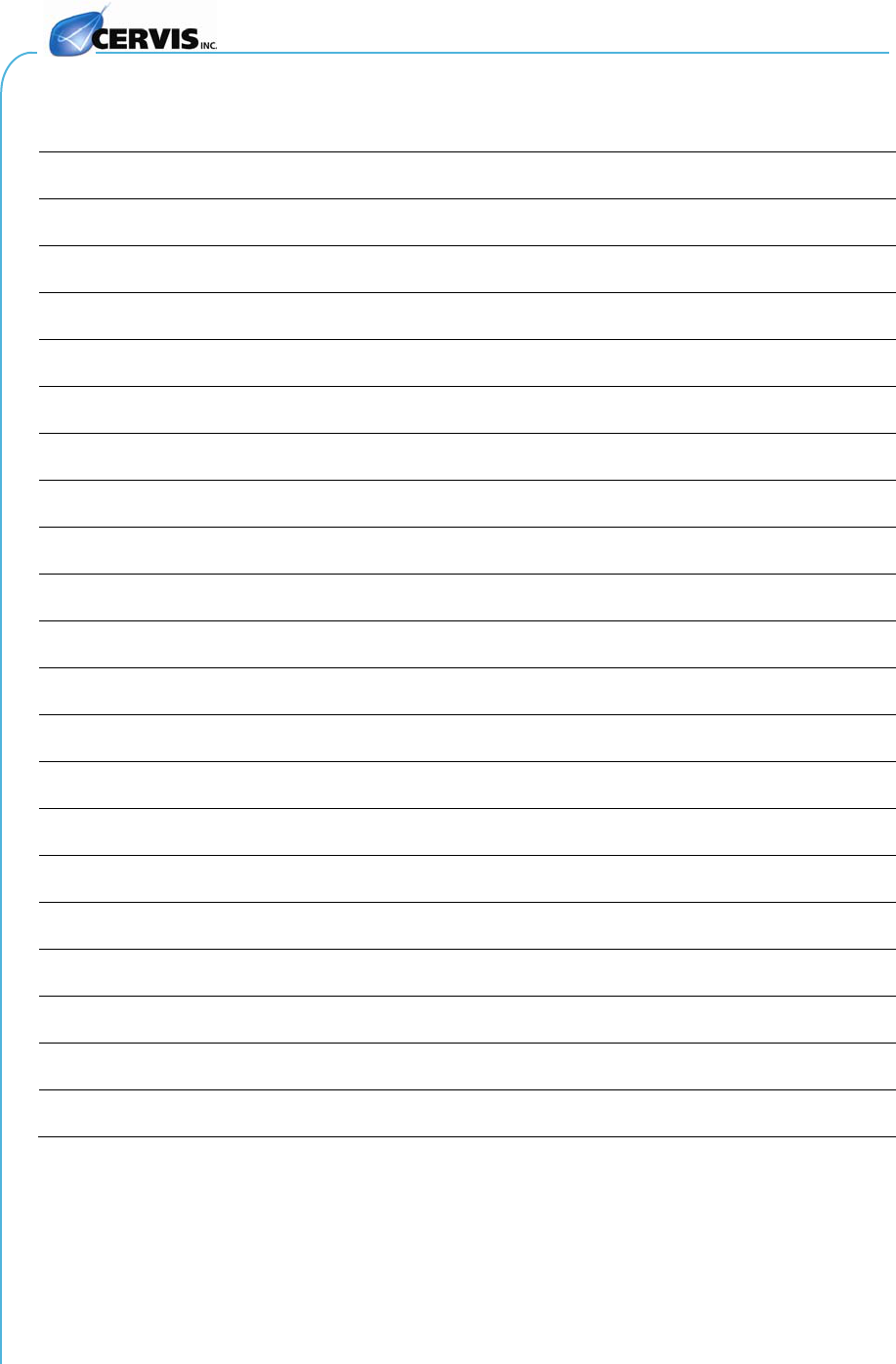
Module SRF309
U081.0.9-SRF309 User Manual
ii
Notes and Observations

User Manual
Cervis Inc. Safety Precautions
Read and follow all instructions.
Failure to abide by Safety Precautions may result in equipment failure, loss of
authority to operate the equipment, and personal injury.
Use and maintain proper wiring. Follow equipment manufacturer instructions.
Improper, loose, and frayed wiring can cause system failure, equipment damage, and
intermittent operation.
Changes or modifications made to equipment not expressly approved by the
manufacturer will void the warranty.
Owner/operators of the equipment must abide by all applicable Federal, State, and
Local laws concerning installation and operation of the equipment. Failure to comply
could result in penalties and could void user authority to operate the equipment.
Make sure that the machinery and surrounding area is clear before operating. Do not
activate a remote control system until certain that it is safe to do so.
Turn off the module power before attempting any maintenance. This will prevent
accidental operation of the controlled machinery.
Do not allow liquid to enter the module enclosure. Do not use high pressure
equipment to clean the module.
Operate and store units only within the specified operation and storage temperatures
defined in the Specifications of this document.

Module SRF309
U081.0.9-SRF309 User Manual
2
1.0 SRF309 Introduction
The SRF309 receive/transmit module (RTM) is based on a single-chip radio frequency (RF)
transceiver integrated circuit (RFIC), an Atmel AT86RF212B. The SRF309 RTM is intended to
be integrated into Cervis Inc. products, providing a wireless RF connectivity option.
The SRF309 RTM operates in the 915 MHz ISM band, using spread spectrum modulation
with a maximum conducted RF transmit power of +8.60dBm at the antenna port.
The RFIC generates RF signals compliant with the Zigbee standard, IEEE 802.15.4-2006.
The spread spectrum technique is direct sequence (DSSS), the modulation method is binary
phase shift keying (BPSK).
The RFIC has internal control registers that the host application can access via a serial
peripheral (SPI) bus. These registers control all aspects of how the RFIC is used, which must be
compliant with all applicable rules and regulations.
The SRF309 RTM is interoperable various other Cervis Inc. RTMs that use the same
modulation and message data structure. Interoperability with non-Cervis RTMs, while possible,
is not supported.
The SRF309 RTM is most commonly applied in half-duplex master/slave systems: the master
transmits a message to a slave, the slave transmits a reply to the master. Other operating
modes are possible, provided that applicable rules and regulations are not violated.
The SRF309 RTM may be realized in various PCB shapes, some with non-RF circuits
applicable to the requirements of particular hot applications. Mechanical variations include:
07440305-9H-12R “Type 1” (tested, pictured)
07610304-9H “Type 2” (not yet tested)
07420305-9H-12R “Type 3” (not yet tested)
14001301 “Type 4” (not yet tested)
1.1 SRF309 Features
FCC Part 15 certified
IC Certified
CE certified
905-925 MHz Operation
2 MHz Selectable Channels
Direct Sequence Spread Spectrum (DSSS)
Binary Phase Shift Keying (BPSK) modulation (tested)
40 kbps Data Rate (tested)
Up to +8.60dBm Output Power (tested)
IEEE
802.15.4-2006 messaging
SPI host interface
Simple power requirements: 3.0-3.3V low noise regulated, 20mA
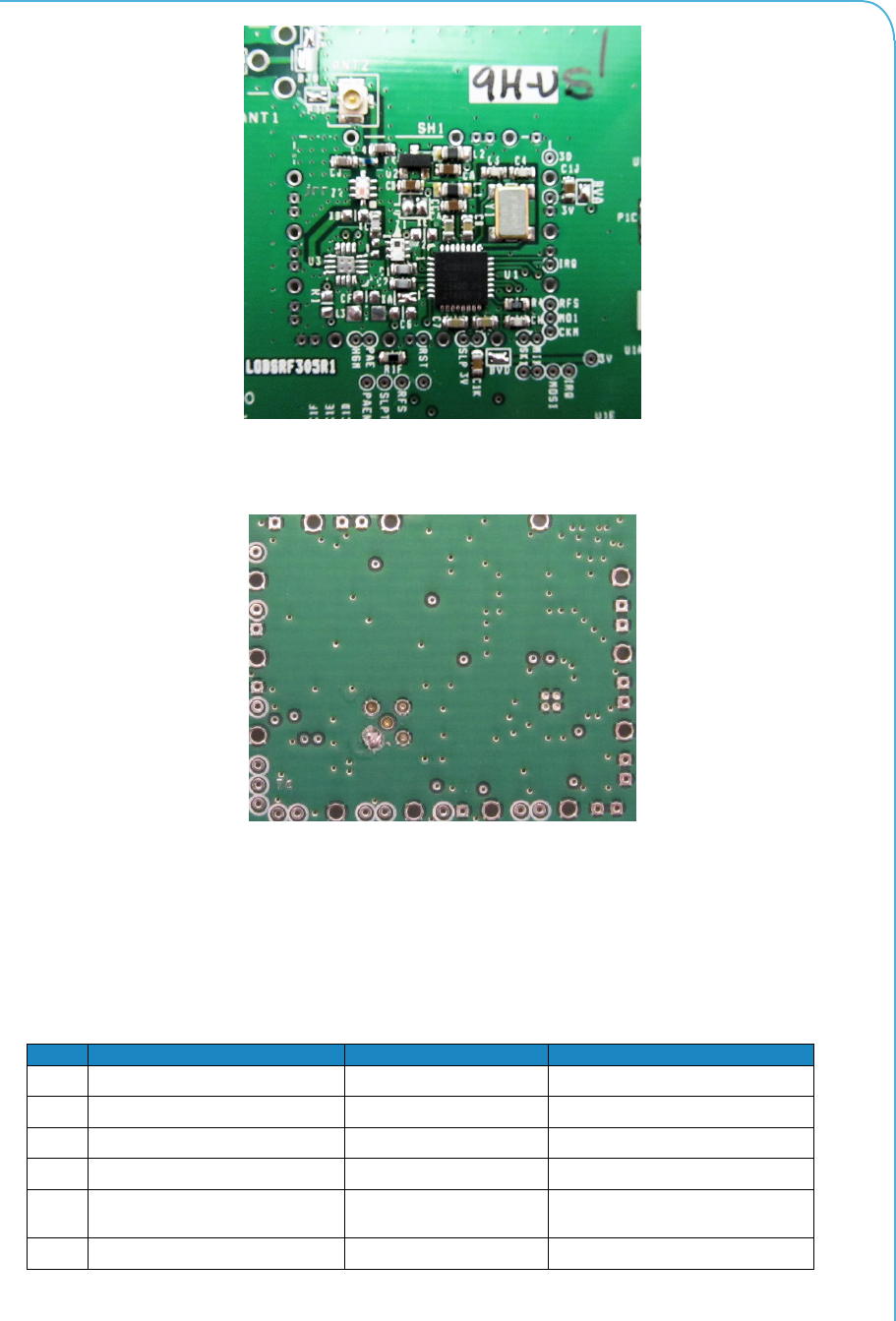
User Manual
2014Cervis, Inc. 3
Figure 1. SRF309 RF section Front
Figure 2. SRF309 RF section Back
1.2 SRF309 Pinouts
Table 1-4 show the pinouts and interface signals on several alternative packaging options for the
SRF309 RTM:
Table 1. 07440205 PCB (SRF309 Type 1) – connector HDR1
Pin Name Signal Details
1 SPI_CLK SPI data clock in Clock from SPI master
2 GND ground Low impedance ground
3 MISO SPI data out Data from SPI slave
4 MOSI SPI data in Data from SPI master
5 RF_SLP_TR RFIC control Multipurpose control signal from
master
6 /RF_RST RFIC reset Low from SPI master
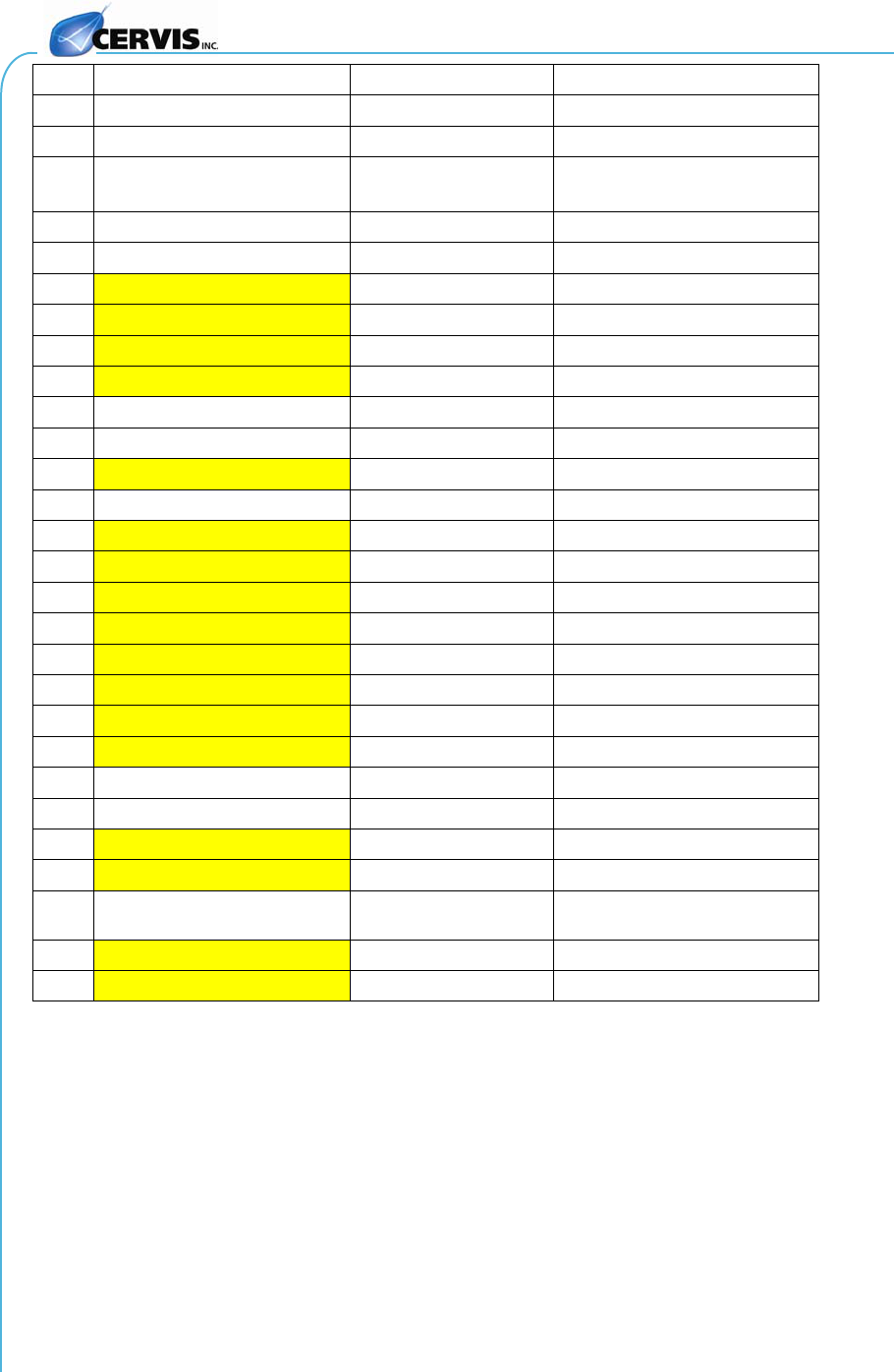
Module SRF309
U081.0.9-SRF309 User Manual
4
7 /RF_CS RFIC chip select Low from SPI master
8 RF_IRQ RFIC interrupt output Input to SPI master
9 RF_PAEN Enable external PA High from SPI master
10 RF_HGM/BPA Enable external LNA or
Read BPA jumper
Function not used in SRF309
Input to SPI master
11 GND ground Low impedance ground
12 GND ground Low impedance ground
13 DISPLAYCS Display chip select Low from SPI master
14 /RFEE_CS (reserved) EE chip select Low from SPI master
15 DISPLAYRS Display register select From SPI master
16 DISPLAYBLANK Display on/off From SPI master
17 reserved reserved reserved
18 reserved reserved reserved
19 DISPLAYRST Display reset Low from SPI master
20 reserved reserved reserved
21 LED_6 Indicator High from SPI master
22 LED_7 Indicator High from SPI master
23 LED_4 Indicator High from SPI master
24 LED_5 Indicator High from SPI master
25 LED_2 Indicator High from SPI master
26 LED_3 Indicator High from SPI master
27 LED_0 Indicator High from SPI master
28 LED_1 Indicator High from SPI master
29 GND ground Low impedance ground
30 GND ground Low impedance ground
31 +24VDC +3.0-30V Power indicator LED
32 +5VDC +3.0-30V Power indicator LED
33 +3.3VDC +3.3V Power indicator LED, RF & logic
power. Low noise 50mA max.
34 REVBAT +3.0-30V Power indicator LED
Not required for SRF309
The 07440305-9H-12R PCB assembly includes all circuits and features required for properly
implementing the SRF309 RTM. The PCB also provides circuits and mounting for various
optional non-RF features of use to a host application, including:
12 indicator LEDs (default installation)
LED/LCD display module (future use)
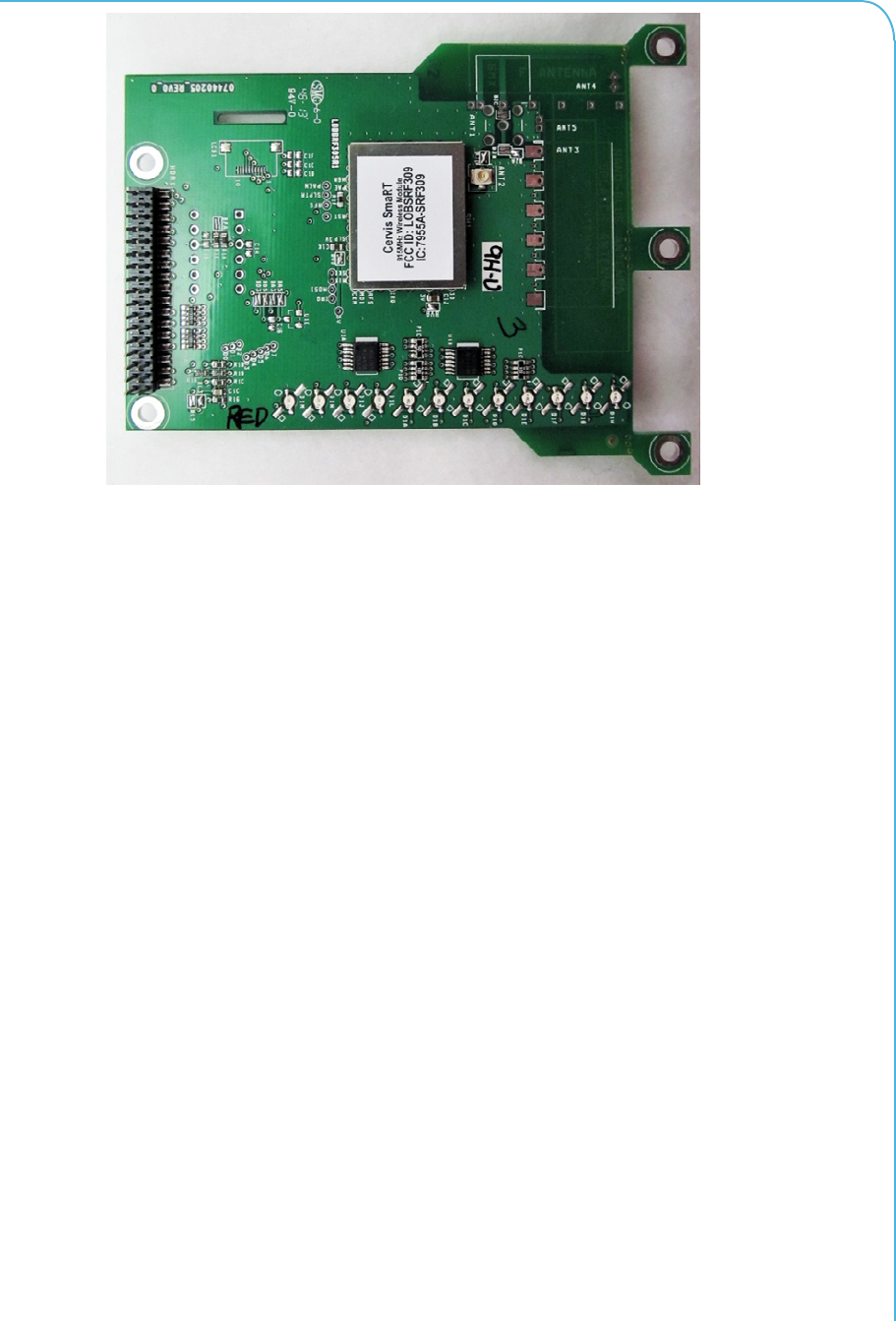
User Manual
2014Cervis, Inc. 5
Figure 3. 07440305-9H-U-12R, component side, shield, internal label, external antenna
connector
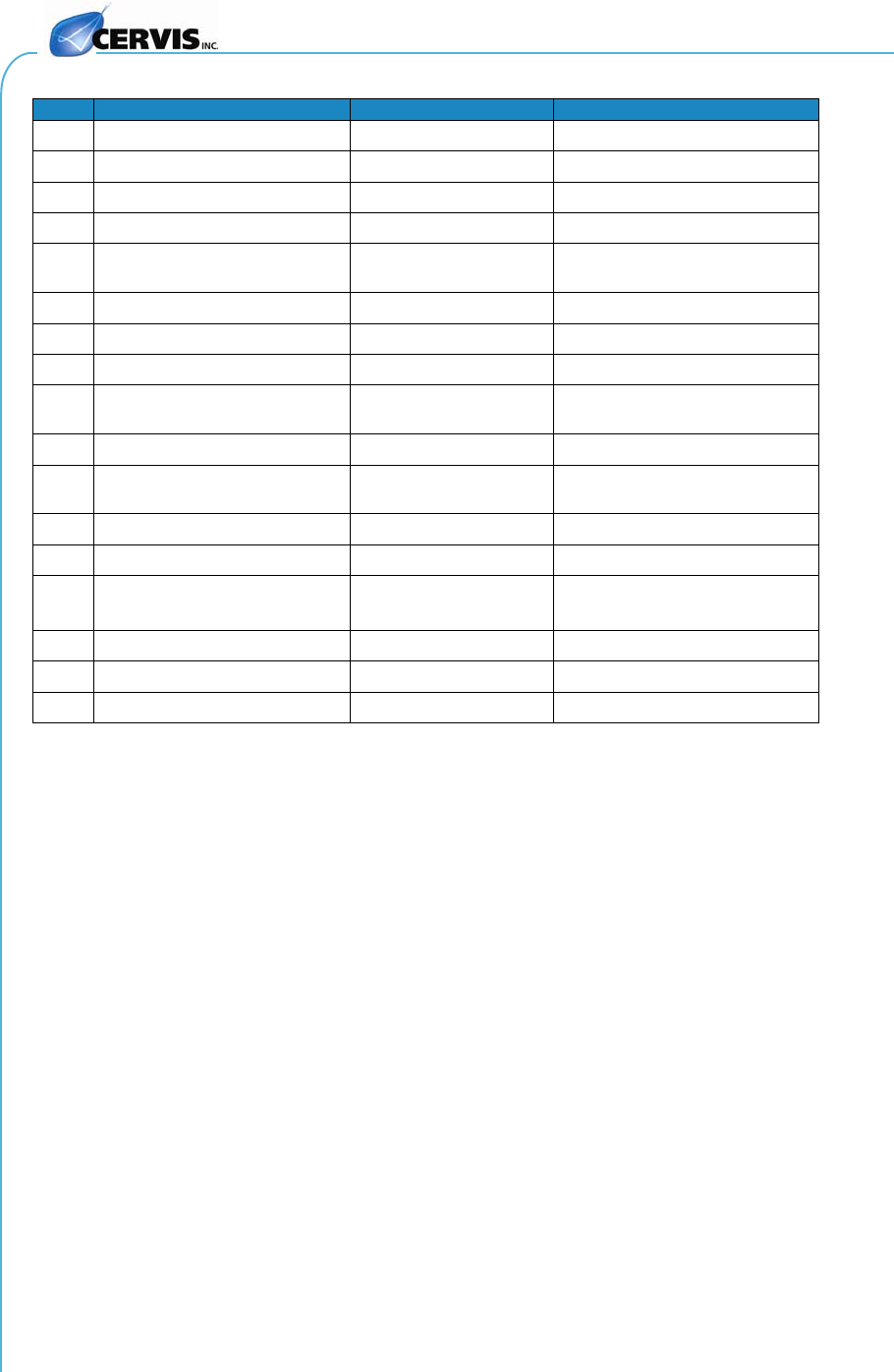
Module SRF309
U081.0.9-SRF309 User Manual
6
Table 2. 07610204 PCB (SRF309 Type 2) – connector J10
Pin Name Signal Details
1 SPI_CLK SPI data clock in Clock from SPI master
2 GND ground Low impedance ground
3 MISO SPI data out Data from SPI slave
4 MOSI SPI data in Data from SPI master
5 RF_SLP_TR RFIC control Multipurpose control signal from
master
6 /RF_RST RFIC reset Low from SPI master
7 /RF_CS RFIC chip select Low from SPI master
8 RF_IRQ RFIC interrupt output Input to SPI master
9 RF1_3VD +3.3V RF & logic power. Low noise
25mA max.
10 GND ground Low impedance ground
11 RF1_3VA +3.3V RF analog power. Low noise
25mA max.
12 GND ground Low impedance ground
13 RF_PAEN Enable external PA High from SPI master
14 RF_HGM/BPA Enable external LNA or
Read BPA jumper
Function not used in SRF309
Input to SPI master
15 GND ground Low impedance ground
16 GND ground Low impedance ground
17 GND ground Low impedance ground
The 07610305-9H PCB assembly includes all circuits and features required for properly
implementing the SRF309 RTM Type 2.
Insert image of 07610304-9H when available
Figure 4. 07610304-9H, component side
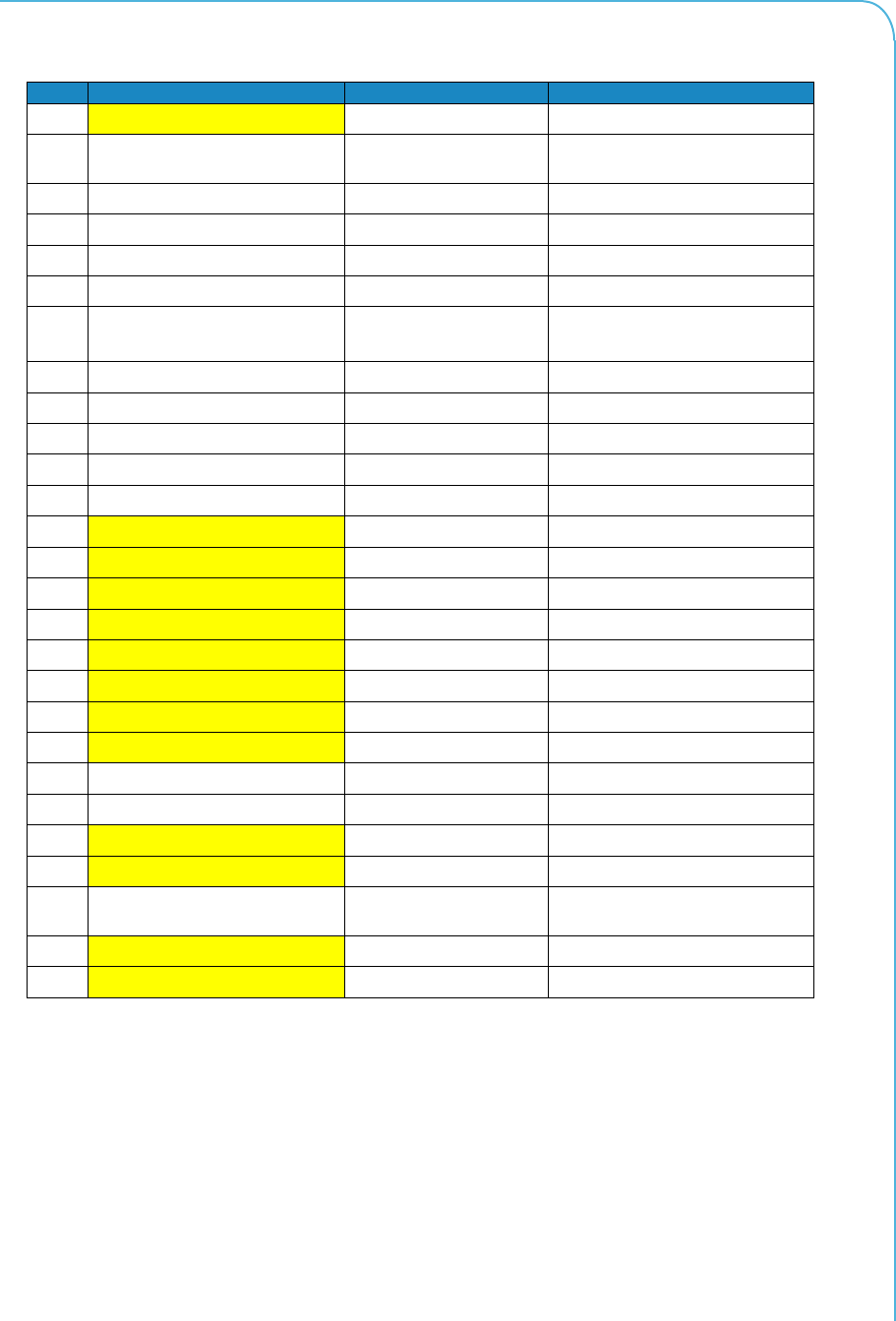
User Manual
2014Cervis, Inc. 7
Table 32. 07420205 PCB (SRF309 Type 3) – connector HDR1
Pin Name Signal Details
1 /RFEE_CS (reserved) EE chip select Low from SPI master
2 RF_SLP_TR RFIC control Multipurpose control signal from
master
3 /RF_RST RFIC reset Low from SPI master
4 RF_IRQ RFIC interrupt output Input to SPI master
5 /RF_CS RFIC chip select Low from SPI master
6 RF_PAEN Enable external PA High from SPI master
7 RF_HGM/BPA Enable external LNA or
Read BPA jumper
Function not used in SRF309
Input to SPI master
8 SPI_CLK SPI data clock in Clock from SPI master
9 MOSI SPI data in Data from SPI master
10 MISO SPI data out Data from SPI slave
11 GND ground Low impedance ground
12 GND ground Low impedance ground
13 LED_7 Indicator High from SPI master
14 LED_6 Indicator High from SPI master
15 LED_5 Indicator High from SPI master
16 LED_4 Indicator High from SPI master
17 LED_3 Indicator High from SPI master
18 LED_2 Indicator High from SPI master
19 LED_1 Indicator High from SPI master
20 LED_0 Indicator High from SPI master
21 GND ground Low impedance ground
22 GND ground Low impedance ground
23 REVBAT +3.0-30V Power indicator LED
24 +5VDC +3.0-30V Power indicator LED
25 +3.3VDC +3.3V Power indicator LED, RF & logic
power. Low noise 30mA max.
26 +24VDC +3.0-30V Power indicator LED
Not required for SRF309
The 07420305-9H-12R PCB assembly includes all circuits and features required for properly
implementing the SRF309 RTM Type 3. The PCB also provides circuits and mounting for
various optional non-RF features of use to a host application, including:
12 indicator LEDs (default installation)
insert picture when available
Figure 5. 07420305-9H-12R, component side
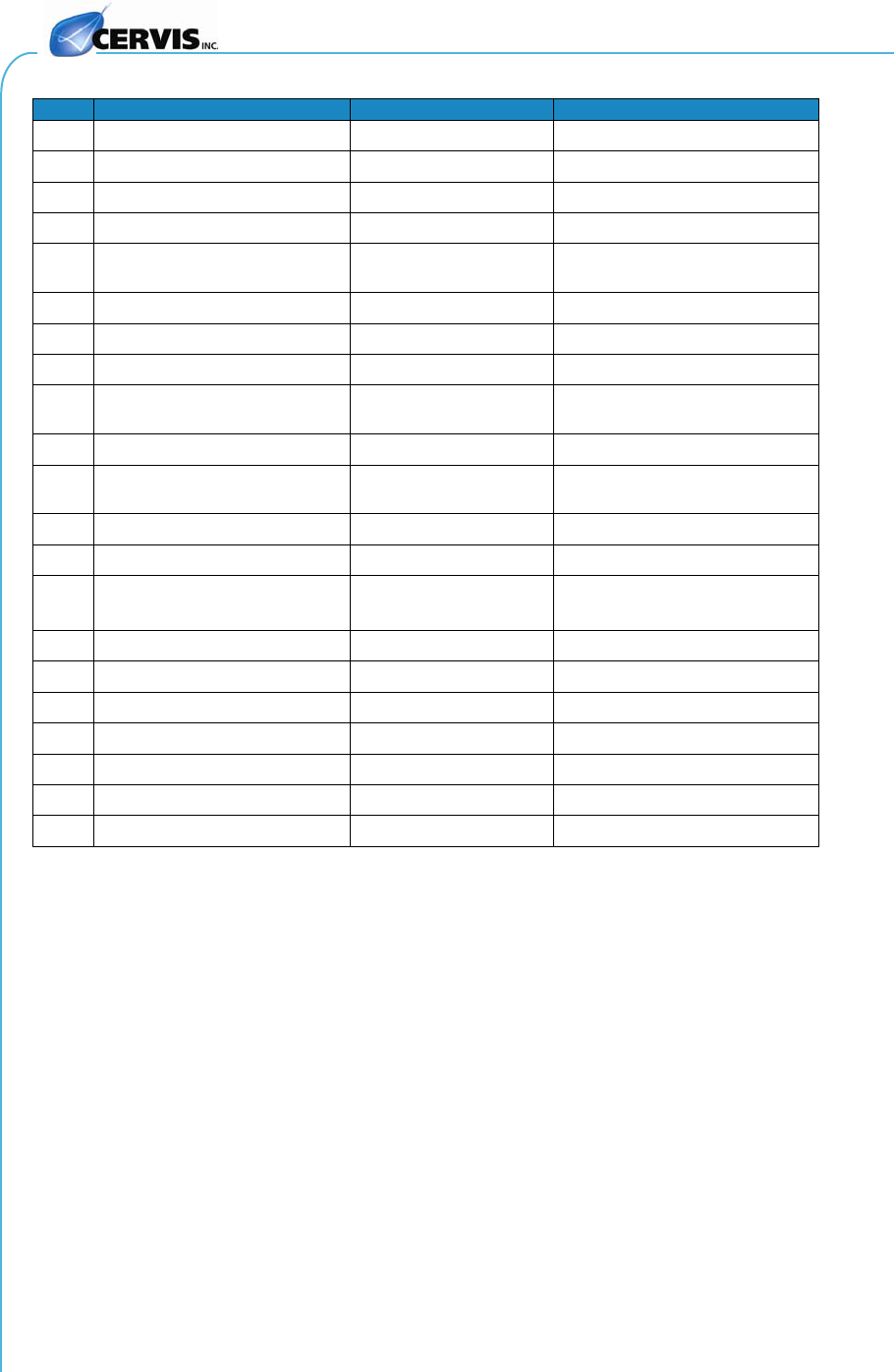
Module SRF309
U081.0.9-SRF309 User Manual
8
Table 3. 14001200 PCB (SRF309 Type 4) – connections
Pin Name Signal Details
1 SPI_CLK SPI data clock in Clock from SPI master
2 GND ground Low impedance ground
3 MISO SPI data out Data from SPI slave
4 MOSI SPI data in Data from SPI master
5 RF_SLP_TR RFIC control Multipurpose control signal from
master
6 /RF_RST RFIC reset Low from SPI master
7 /RF_CS RFIC chip select Low from SPI master
8 RF_IRQ RFIC interrupt output Input to SPI master
9 RF1_3VD +3.0-3.3V RF & logic power. Low noise
25mA max.
10 GND ground Low impedance ground
11 RF1_3VA +3.0-3.3V RF analog power. Low noise
25mA max.
12 GND ground Low impedance ground
13 RF_PAEN Enable external PA Active high from SPI master
14 RF_HGM/BPA Enable external LNA or
Read BPA jumper
Function not used in SRF309
Input to SPI master
15 GND ground Low impedance ground
16 GND ground Low impedance ground
17 GND ground Low impedance ground
18 GND ground Low impedance ground
19 GND ground Low impedance ground
20 RF Port Antenna connection 50 Ohm RF In/Out port
21 GND ground Low impedance ground
The 14001301 PCB assembly includes all circuits and features required for properly
implementing the SRF309 RTM Type 4.
Insert image of 14001301 when available
Figure 4. 14001301, component side

User Manual
2014Cervis, Inc. 9
2.0 SRF309 Installation
When integrating an SRF309 RTM into a host application, the user must provide all text in the
“FCC Statements” and “Industry Canada Statements” in the host application’s user manual (see
Forward Material). The text must not be modified in any way and presented in a conspicuous
manner that the end user can be reasonably expected to access.
When integrating the SRF309 RTM into host application hardware, the user must properly
connect all the circuits identified in Table 1 to suitable host application signals. The host
application firmware must properly control the RTM to ensure that emitted RF signals comply
with all applicable regulatory approvals.
The SRF309 RTM is always provided with an approved type of antenna, either internal fixed
or external replaceable. If a fixed internal antenna is provided as part of the RTM, the on-board
coaxial cable connectors are not populated. If the module is assembled for use with an external
antenna, one of the on-board coaxial cable connector positions will be populated. The choice of
the particular type of coaxial connector that is installed will be decided by the designer of the
host application. The on-board connector is not accessible to users, so it does not need to be
unique.
When provided, external replaceable antennas always have a unique connector such as: RP-
N, U.FL/IPEX, RP-SMA, RP-BNC or RP-TNC. A suitable coaxial cable jumper with appropriate
connectors must be used to connect the SRF309 RTM external antenna port to the external
antenna. The details of a particular host application will affect the design of the jumper coax, but
the external connector must always be of an acceptable unique type.
The coaxial cable used to make the jumper between the RTM and the external antenna
mounting position must be suitable for use at 915 MHz and have 50 Ohm impedance. Low loss
cable such as RG-316 is suggested, although signal loss will be small if the jumper length is
short.
External coaxial cables may be used to help mount the replaceable external antenna in a
more useful location. Such cable must have appropriate unique connectors and must be made
from low loss 50 Ohm coaxial cable. Cables equivalent to LMR-195 are suitable for lengths up to
30 feet. Longer cables must have suitably lower signal loss, typically using larger cable such as
LMR240, LMR-300, or larger (or equivalent). At some point, a practical limit is reached where
losses in extension cables negate any gains from relocating the antenna.
3.0 SRF309 Tune-up Procedure
There is no tune-up procedure. The module contains no adjustable components.
Proper RF operation of the module is verified during the manufacturing process using
suitable equipment and methods.
4.0 SRF309 Electrical Characteristics
4.1 Supply Voltage and Current
The SRF309 RTM (the components under the RF shield) requires the host application to provide a
low noise (linear regulator as opposed to a switching regulator) regulated 3.0-3.3 VDC source that
can provide 20mA without losing regulation. The RTM does not provide under-voltage, over-voltage,
or reverse polarity protection so use caution when applying power. The RTM contains a low noise
linear 2.5V regulator (Fig 1.”U2”, top-center) that buffers the analog power to the RFIC RF section.
The RFIC has another internal low noise 1.8V regulator (see the data sheet for Atmel AT86RF212B).

Module SRF309
U081.0.9-SRF309 User Manual
10
All external connection pints designate as signal “GND” should be connected to the host
application “GND” circuit so as to maintain as low a resistive and reactive impedance as
practical. The PCB hosting the RTM should be fabricated with low impedance copper floods that
connect to “GND”.
The SRF309 RTM can safely operate with a supply voltage over the range of 3.0-3.3V with
minimal changes in RF performance. Testing was performed at 3.3V, the preferred supply
voltage.
Some implementations of the SRF309 module may have additional non-RF functions. The
additional circuits may draw current in addition to what the SRF309 RF circuits use.
4.2 Operating Current
The SRF309 RTM has four primary operating conditions that draw differing amounts of current
from to 3.0-3.3V power source:
Off RFIC is powered down, minimal load
PLL_ON RFIC is ready to transmit or receive, ~5mA
RX RFIC is receiving a message, ~12mA
TX RFIC is transmitting, ~15-20mA, depending on TX output power
In TX mode the operating current may be less than the maximum if the drive to the external
PA is reduced because the full +8.60dBm RF output power is not required.
4.3 SPI Interface
The SPI interface between the RFIC (slave) and the host application (master) microcontroller
requires four signals:
SCLK – The serial data clock from the SPI master. Must be less than 8 MHz.
MOSI – Serial data from the SPI master.
MISO – Serial data from the SPI slave.
RF_CS – Chip select from the SPI master.
The SPI controller setting must be established by the host application microcontroller to be
compatible with the SPI interface timing specified by the RFIC data sheet.
5.0 SRF309 RF Characteristics
5.1 General RF Information
The RFIC used in the SRF309 RTM implements RF modulation modes and timings in
compliance with IEEE 802.15.4-2006. The RFIC implements additional proprietary RF
modulation modes. Details may be found in the AT86RF212B RFIC data sheet.
The SRF309 general spread spectrum scheme is DSSS. The modulation type is BPSK. The
data rate is 40kbps.
5.2 RF Exposure Considerations
The antennas used with the SRF309 RT module should be positioned to minimize possible
RF exposure hazards. Handheld applications of the SRF309 RT module must maintain an antenna
separation distance >15mm when used in a normal operating pose. Mobile applications of the

User Manual
2014Cervis, Inc. 11
SFR309 RT module must maintain an antenna separation distance >20cm away from areas that are
likely to be occupied by human body parts.
These separation requirements must be included in end-user manuals for host applications
that include an SRF309 RT module.

Module SRF309
U081.0.9-SRF309 User Manual
12
Visit our Web site at: www.cervisinc.com
2014 Cervis, Inc. All rights reserved. Content is subject to change without notice.